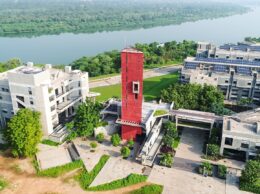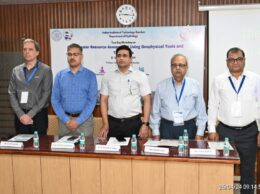CHENNAI : An Indian Institute of Technology Madras (IIT Madras)-led international research team studied how atmospheric conversion of gaseous emissions from power plants into particulate matter (PM) results in particles that are rich in sulphate and consequently have high cloud forming potential compared to natural counterparts. This study may provide important scientific insights for framing the policies related to controlling the PM2.5.
Demonstrating the true multidisciplinary nature of climate change research, IIT Madras led this global collaborative effort where a group of 27 researchers from 17 distinct institutions across eight countries participated.
The researchers, led by Prof. Sachin S. Gunthe from the Centre for Atmospheric and Climate Sciences at IIT Madras, delved into the impact of emissions from the Neyveli coal-fired power plant located about 200 km south of Chennai, Tamil Nadu, on aerosol growth and cloud-forming properties during the COVID-19-induced lockdown.
This investigation, conducted amidst the COVID-19 lockdown in India, imparts valuable insights into the consequences of reduced human-related emissions on aerosol traits and cloud formation, thereby advancing our comprehension of the implications of coal-fired power plant emissions in the context of climate change.
The findings of this study are reported as a scientific research paper published this week in the reputed peer-reviewed npj Climate And Atmospheric Science (doi.org/10.1038/s41612-023-00430-2), which is part of the prestigious Nature Group of Publications and has an Impact factor of 9.5.
Highlighting the important outcomes of this study, Prof. Sachin S. Gunthe, Coordinator, Centre for Atmospheric Sciences, Department of Civil Engineering, IIT Madras, said, “Our study provides a rare opportunity to examine the sensitivity of cloud-forming aerosol particles to new particle formation and growth due to SO2 emissions from a coal-fired power plant under relatively cleaner conditions. These findings have important implications for assessing the climate impacts of anthropogenic aerosols and highlight the need for comprehensive emission control measures.”
Implications for Regional Air Pollution
The observations and analyses presented in the research paper offer a rare chance to explore how aerosols with the ability to form clouds react to new particle formation and growth resulting from SO2 emissions from a coal-fired power plant. This occurs under relatively cleaner conditions in tropical India. These findings are of immense importance to climate modellers as they establish a baseline for comparison against the typically prevalent conditions in heavily polluted coastal Indian cities.
A doctoral student at the Centre for Atmospheric and Climate Sciences, IIT Madras, Ms. Aishwarya Singh, who hails from Gorakhpur, single-handedly calibrated, maintained, and operated the set of six advanced and state-of-the-art instruments during COVID-19 induced lockdown under extraordinarily challenging and adverse conditions. The institute administration provided special permissions, strong logistical support, and proper care to Ms. Singh at IIT Madras once she decided to continue the measurements.
Elaborating on the challenging conditions during the lockdown when this research was conducted, Ms. Aishwarya Singh, PhD Scholar, Prime Minister’s Research Fellow (PMRF), Centre for Atmospheric and Climate Sciences, Dept of Civil Engineering, IIT Madras, said, “We had started running our aerosol characterization equipment for routine measurements just a few days before the lockdown was announced and I was presented with an option of shutting down all the instruments and going home by my doctoral advisor. Upon discussing the possibility of continuing the measurements during the lockdown with him, I decided to stay back to carry out the observations, anticipating some interesting scientific findings. Prof. Sachin Gunthe had explained to me the importance of these measurements as chances of having such a unique opportunity may nearly be impossible again, which further boosted my confidence.”
During the lockdown, as anthropogenic emissions, such as traffic and industries, significantly decreased, the researchers observed a drastic reduction in the overall aerosol burden over the study region. This provided a unique opportunity to isolate the impact of specific emission sources, mainly from the power plant, which continued operation during the lockdown, to understand the underlying processes of aerosol formation and its impact on cloud formation and climate.
Implementing aggressive measures to reduce particulate pollution originating from traffic and various industrial sources within coastal regions such as Chennai might lead to outcomes that work against the intended goals. As a result, there is a pressing need for comprehensive reconsideration and the exploration of alternative strategies to address air pollution at the regional level effectively.
A New Direction in Research
Speaking about this research, Prof. Sachin S. Gunthe further added that, “This study’s outcomes imply that the existing strategies aimed at reducing PM2.5 levels from traffic and industries in India’s polluted coastal clusters need thorough revaluation.”
The study found that the conversion of gaseous sulfur dioxide (SO2) emissions from power plants into particulate matter contributes to an elevated mass load of aerosols rich in sulfates with high cloud-forming potential within the atmosphere.
Atmospheric aerosol particles serve a dual role:
Ø They are essential for cloud formation, ensuring the availability of freshwater to sustain life on Earth, and
Ø They also interact with incoming solar radiation, significantly impacting the planet’s radiative budget.
Due to the intricate origins, diverse types, and fluctuations in aerosol characteristics, coupled with a limited scientific understanding of how these ever-changing properties have influenced cloud formation since before industrialization, researchers struggle to precisely forecast the exact temperature rise by the close of this century.
“Conducting comprehensive research of this nature holds significant scientific importance, and such collaborative endeavours are highly essential in India. These endeavours not only contribute to advancing our fundamental comprehension of how aerosol-cloud interactions may shape our climate but also deepen our insights into the regional implications of PM2.5 air pollution,” stated Dr. Shweta Yadav, an aerosol specialist from the Central University of Jammu, who was not involved in this study.
The study revealed a remarkable event where long-range transport of sulphur dioxide (SO2) gas emitted from the Neyveli power plant resulted in new particle formation (NPF) in Chennai, generating particles generally known as ‘secondary aerosols.’
The findings demonstrated that the SO2 plume from the power plant resulted in high particulate sulphate concentrations and subsequent particle growth. These sulphate-rich particles rapidly grew into the size relevant and required for the cloud formation exhibiting a high ability to uptake water, thus enhancing the cloud-forming potential of the aerosol particles, which is nominally not the case during business-as-usual scenarios.
The researchers successfully demonstrated that when local sources of anthropogenic emissions stop, the SO2 emissions from power plants may amplify the mass of PM2.5 through the formation of new particles, which contradicts common assumptions. The study emphasized that, therefore, under cleaner conditions with reduced human activities, the availability of low-volatility vapours of specific gases increases the chances of formation and growth of new aerosol particles, as opposed to the business-as-usual scenario where these low-volatile gases may condense on pre-existing aerosol particles resulting from human activities in an urban setup like Chennai.









